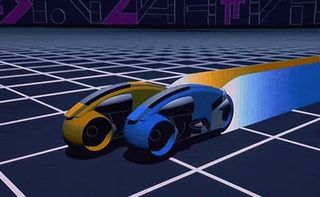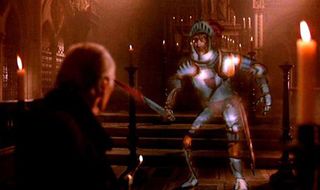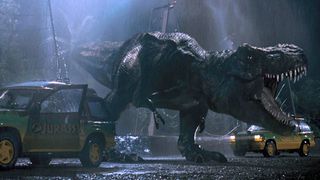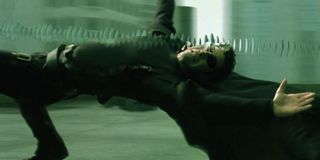The 10 most important VFX shots of all-time
Discover the biggest milestones in the history of CG and how they got us to where we are today.
Over the years there have been a number of VFX shots that have helped shape our industry, and in many cases moved it forward through innovation. Arguably this list could be far longer than 10, however we've distilled this down to select few that we believe have had the biggest impact in the long-term.
Don't miss The VFX Festival, created by Escape Studios, part of Pearson College London, which run from February 23rd - 25th 2016 at London's O2.
01. Tron (1982)

This was the first major use of computer generated imagery, and signaled what was about to be possible. It was a huge risk on the part of Disney to use this much CG in a movie for the very first time.
Despite most of the action supposedly taking place in a computer, there's actually only around 15 minutes of CG, and even this used up pretty much all of the processing power available at the time. They did it to prove a point, and say…. "Hey, look at what we can do with CG…"
02. Wrath of Khan (1982)
Just how do you create something that has no solid surface and travels across an entire planet like wildfire? Call in the computer programmers. Technically it pushed the boundaries by fluid simulations specifically for film, which in 1982 was a massive feat.
03. Young Sherlock (1985)

This film featured the first CG character. This was driven by the immensely talented John Lasseter (who went on to found Pixar). This was the first time a character has been brought to life by CG in a major film, previously it had been about replacing physical effects. Now we were able to bring to life inanimate objects and make them move like a human character.
04. Abyss (1989)
Although liquid effects on show here were made famous by Terminator 2, they first appeared in Abyss and are a great example of where CG solved a problem. The creature was made of water and had to move and take on features of a human face. CG made this believable, it was impossible for this to be done in any other way.
Get the Creative Bloq Newsletter
Daily design news, reviews, how-tos and more, as picked by the editors.
05. Jurassic Park (1993)

Seeing a believable dinosaur was every kid's dream, and for the first time we saw creatures that were as detailed as our imaginations. The sheer scale and realism was incredible and realistic movement of whole 'flocks' of digital dinosaurs were now possible. Although we don't truly know what dinosaurs looked like, we completely believed what we saw in Jurassic Park, and to this day, many accept this is how these prehistoric monsters looked.
06. Star Wars trilogy (1977 originals reimagined for 1997)
This illustrates the power of VFX, by showing that it isn't all about blowing stuff up and making jaw-dropping effects, it is about creating believable scenes that feel completely natural. The task of putting new effects into a 70s film without it looking out of place was huge, and hugely controversial!
The result of the work on the updated version of Star Wars was amazing. From creating a gruesome Jabba the Hutt, complete with tail, required the studio to adjust seamlessly the original shots with Harrison Ford even stepping over his tail, where in the original there was just unobstructed space. If you hadn't seen the original, you'd think that the new additions were there from the start.
07. The Matrix (1999)

Arguably, this reinvented the VFX blockbuster, and 'bullet time' was the standout piece. Shots were taken from multiple angles and then stitched together digitally, allowing for super-slow-mo visuals that circled the subject. The film received huge accolades for this innovation, and the process made this a must-see movie.
08. Lord of the Rings (2001)
Up until this point, putting Tolkien's trilogy on the screen would have been impossible due to the vast amount of VFX required to do it justice. Gollum was one of the biggest talking points from the movie and put the term 'mo-cap' in everyday vocabulary. The massive battle scenes presented visuals that were never before seen at that scale. The computing power needed to created and simulate the huge scenes was immense and almost unquantifiable, and it kick started an entire VFX industry in New Zealand.
09. Life of Pi (2012)

The tiger - what more to say? You couldn't tell that it wasn't real. This is what VFX is all about, making the unbelievable, believable, and making you ask "how did they do that?"
10. Interstellar (2014)
2014 saw the return to the sci-fi spectacular. The fundamental challenge was, how on earth do you make a realistic black hole, when light bends and distorts as you move closer?
The science that was utilised within the film to create such stunning and believable effects have been turned into technology papers, showing the true depth of the science used. The innovations here were not possible without creating a whole new set of software to make light react in the appropriate way when faced with a black hole.
The VFX Festival, created by Escape Studios, part of Pearson College London will run from February 23rd - 25th 2016 at London's O2. Bringing the best in VFX, games, animation and motion graphics to industry professionals and anyone considering a career in visual effects. Find out more: www.thevfxfestival.com

Thank you for reading 5 articles this month* Join now for unlimited access
Enjoy your first month for just £1 / $1 / €1
*Read 5 free articles per month without a subscription

Join now for unlimited access
Try first month for just £1 / $1 / €1
The Creative Bloq team is made up of a group of design fans, and has changed and evolved since Creative Bloq began back in 2012. The current website team consists of eight full-time members of staff: Editor Georgia Coggan, Deputy Editor Rosie Hilder, Ecommerce Editor Beren Neale, Senior News Editor Daniel Piper, Editor, Digital Art and 3D Ian Dean, Tech Reviews Editor Erlingur Einarsson, Ecommerce Writer Beth Nicholls and Staff Writer Natalie Fear, as well as a roster of freelancers from around the world. The ImagineFX magazine team also pitch in, ensuring that content from leading digital art publication ImagineFX is represented on Creative Bloq.
